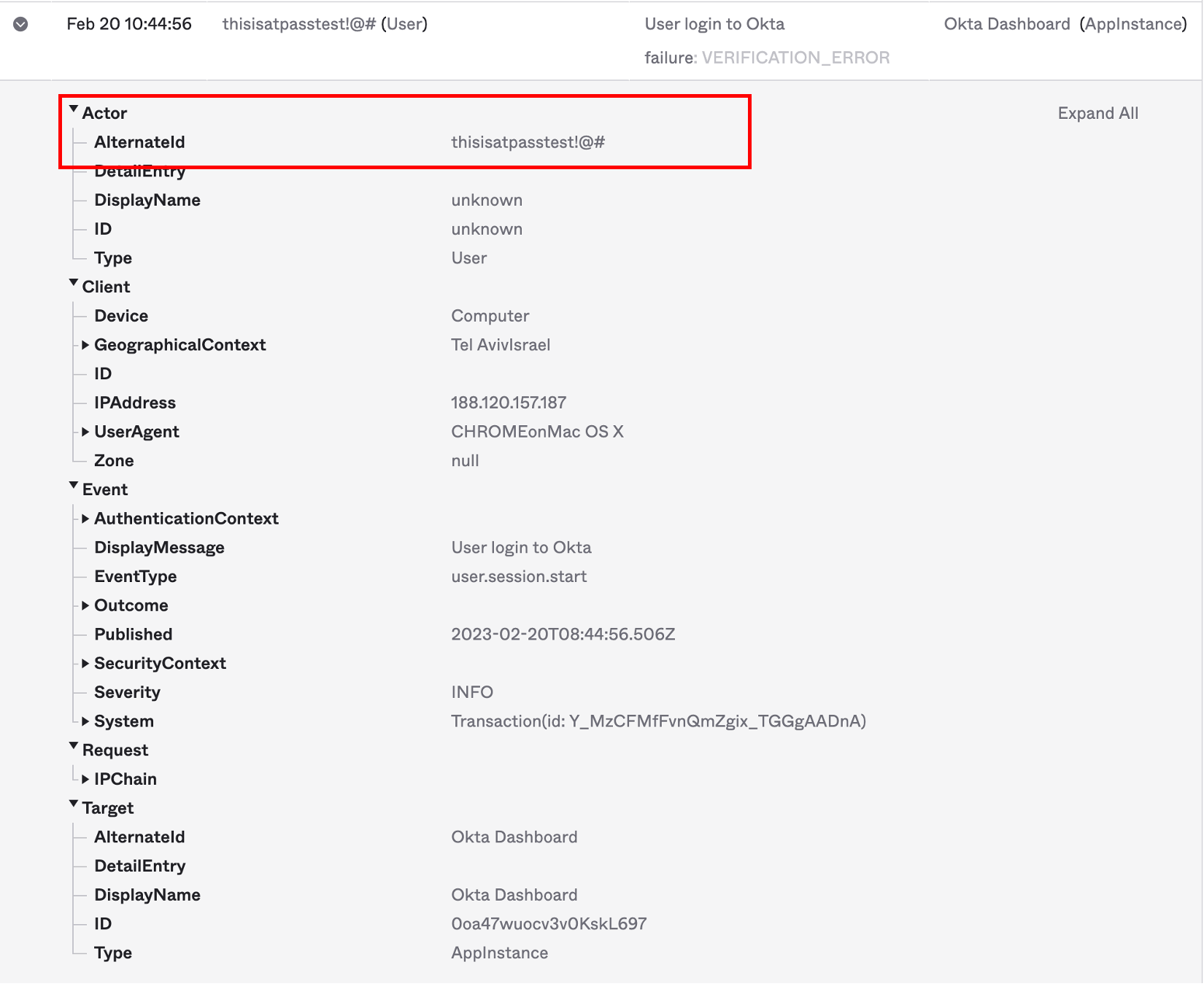Abstract
Mitiga researchers have found a new potential post-exploitation attack method in Okta that enables adversaries to read users’ passwords and credentials that are in the Okta audit logs. This knowledge can then allow adversaries to compromise Okta user accounts and access any resources or applications that they may have access to, effectively expanding the blast radius of the attack. This could include sensitive data, intellectual property, financial information, or customer data.
Adversaries with access to Okta audit logs, whether obtained directly through the admin console or through other systems where logs are shipped, could read Okta users’ passwords if they had been input incorrectly in the username field during login.
This exposure is possible because of the way Okta records failed login attempts to Okta instances. While it may seem like an edge case, this kind of password mistake is a common one for users. As a result, it poses a risk to many Okta customers.
What risk have we identified?
When a user logs in to their Okta domain, it's quite common for them to mistakenly enter their password in the username field on the login page, resulting in login failure. However, the unfortunate consequence of that action is that the failed login request is recorded in Okta audit logs, including the password in plain text in the username section. In most cases, users will subsequently do a successful login, registering the actual correct username in the log file.

As part of Mitiga’s ongoing SaaS threat hunting activities, we analyzed the Okta audit logs for both successful and failed login attempts. We found that Okta's audit logs supply detailed information about user activity, including usernames, IP addresses, and login timestamps. In addition, the logs provide insight into whether login attempts were successful or unsuccessful, and whether they were performed via a web browser or a mobile app.
In our analysis, we discovered that passwords were present in the username field of failed login attempts. This is a concerning finding, as passwords should never be present in plain text in any type of log.

How can this be used for malicious purposes?
By knowing the credentials of users, an attacker can try to log in as those users to any of the organization’s different platforms that use Okta single sign on (SSO). Also, this information could be used to escalate privileges in the case of exposed administrator’ passwords.
To gain this user information, an attacker only needs the ability to read Okta audit logs. Here are a couple of examples of how an attacker would be able to read those logs.
User compromised
The audit logs are saved in the organization’s SIEM solution such as Splunk. An attacker with permission to read the logs in the SIEM product, can harvest users’ credentials. In addition, in such a scenario every user with read-only access to the SIEM solution (all SOC personnel) could potentially have access to other users’ passwords, including Okta admins.
Supply-chain attacks
Third party services which have permissions to read Okta configuration. Products and services that integrate with Okta like CSPM products may request a “Read-only” Administrator role, which gives permissions to only read environment information. The role includes the ability to read the audit logs, which means those products/services could read users’ credentials. So, in cases when those services/products get breached, the attacker can steal the Okta users' credentials.
How to know if your organization is affected?
To detect if user passwords have been mistakenly entered in the username field and are exposed in company logs, organizations can use their log analytics platform or SIEM where the Okta logs are stored. This type of security risk can occur in any organization that uses Okta for identity and access management. We have created a SQL query that can help companies identify these potential password exposures. However, this query can be adapted to other log analytics platforms as well, depending on the specific syntax and functionalities they support.

Logic:
- Extract date and hour of the login attempt, device fingerprint, source IP address, and source user agent from raw Okta logs. (“t0” table)
- Filter for successful login attempts (event_type: core.user_auth.login_success) to create a "success" table.
- Filter for failed login attempts (event_type: core.user_auth.login_failed) with potential passwords in the user_email field to create a "passw" table.
- Define password patterns using regex to filter out noise and validate passwords (at least one uppercase, one lowercase, one digit, and one symbol/special character).
- Join the success and passw tables by date, hour, device fingerprint, source IP address, and source user agent to match usernames with their passwords.
Using this method, we were able to identify hundreds of potentially leaked passwords and credentials for our customers, including for administrator-level users.
Does multifactor authentication (MFA) alleviate this risk?
Multifactor authentication (MFA) is an effective way to enhance the security of user authentication in Okta. Okta admins can configure MFA at the organization or application level. With MFA, users are required to provide additional factors (such as a one-time password, biometric authentication, or a security token) in addition to their password when logging into Okta. This can help prevent unauthorized access even if attackers obtain users' credentials.
However, it's important to note that MFA is not foolproof, and attackers can still try to bypass it through various methods. For example:
- Phishing: Attackers can use social engineering techniques to trick users into providing their MFA credentials. This can include fake login pages or phishing emails that ask users to enter their MFA codes or accept the push notification from the authenticator app.
- MFA fatigue: Users can become overwhelmed with multiple MFA requests and begin to approve them without properly verifying the legitimacy of the request. Attackers can take advantage of this by sending a flood of MFA push notifications in a short time frame, causing the user to become fatigued and approve requests without thoroughly checking them. This allows the attacker to gain unauthorized access to the user's account.
- With access to the Okta logs, a threat actor could potentially wait for the perfect time to trigger MFA to circumvent it, by monitoring user’s login pattern and sending the MFA push within a few seconds after a genuine successful login, to make the action looks legitimate to the user.
Real-case attack scenarios of MFA in Okta:
In 2020, a series of phishing attacks targeted Okta customers, aiming to steal their MFA credentials. The attackers used various social engineering techniques to trick users into providing their credentials, including fake Okta login pages and phishing emails. Once the attackers obtained the MFA codes, they could bypass the MFA requirements and access the targeted accounts.
In another incident, a group of attackers used compromised credentials to access a victim's Okta account, which had MFA enabled. However, the attackers were able to bypass the MFA requirements by using a session hijacking technique. This allowed them to take over the victim's account and perform unauthorized activities.
Recommendations
To prevent potential post-exploitation attacks and unauthorized access to Okta, we recommend the following:
- Use the SQL query, which can be found on Mitiga’s GitHub, to detect potential users that enter their password by mistake. Consider rotating their passwords.
- Educate end-users: Organizations should train their employees to avoid entering passwords in the username field on the Okta login page, as this can lead to credential theft.
- Monitor audit logs: Organizations should continuously monitor Okta audit logs for suspicious activities, including failed login attempts, and investigate any anomalies or security incidents promptly.
- Implement MFA: Organizations should enable MFA at the organization or application level to add an extra layer of security to user authentication. MFA can help prevent unauthorized access even if attackers obtain users' credentials.
- Use SIEM securely: If the organization is using a third-party SIEM solution to store audit logs, it is crucial to ensure that the solution is secure and properly configured. This includes implementing access controls and monitoring for any unauthorized access to the logs.
Okta Response
“Okta has reviewed the reported issue and confirmed that it is expected behavior when users mistakenly enter their password in the username field. Okta logs failed login attempts and includes the erroneous username in the logs. These logs are only accessible to Okta administrators, who are the most privileged users in Okta and should be trusted not to engage in malicious activities.”
We at Mitiga partially agree with Okta team. Typically, only users with at least “Read-only Administrator” role can read the logs in the Okta platform. However:
- Even if you are assigned with “Read-onlyAdministrator” role, it doesn’t mean you should have ability to see users’passwords.
- Okta audit logs often get forwarded to a centralized security solution such as SIEM, which means other users that are not Okta administrators can read the logs.
Okta Recommendations
Okta recommends implementing the following strategies to avoid inadvertently logging passwords in the username field
- Implement field validation: Use client-side validation to check that the input in each field matches the expected format. Okta provides the ability to create custom character restrictions for the username field
- Implement FastPass: Okta FastPass is a feature that allows users to sign in with a single click or tap, without entering a username or password. FastPass uses biometric factors or device authentication to verify the user's identity, making it faster and more convenient for users to access their applications while maintaining a high level of security.
- Use clear labels: Ensure that the labels for the username and password fields are clearly labeled with placeholder text within each field to provide a visual cue to the user.
“Additionally, Okta recommends enforcing phising-resistant multi-factor authentication (MFA) to further enhance the security of the Okta platform. By default, MFA is enforced when accessing the Okta Admin console. A bad actor would not be able to access the admin console without providing additional factors for login. Similarly, admins can set up an Authentication Policy that requires additional MFA when logging in to specific applications, which would further restrict what actions a bad actor can perform.”
Summary
During our investigation, we discovered that some Okta logs inadvertently held passwords due to user error. This occurred when users accidentally entered their password in the username field. One of the ways attackers can fetch users' credentials is by reading the Okta audit logs from the SIEM product the organization uses. Then the attackers can try to bypass the MFA through various methods. Our team built a SQL query to match failed login attempts with a password pattern to subsequent successful login attempts, that you can use to detect if there are users' credentials in your Okta audit logs. We urge Okta users to be mindful of their login credentials and to ensure that passwords are entered correctly in the right field.
LAST UPDATED:
June 23, 2025


